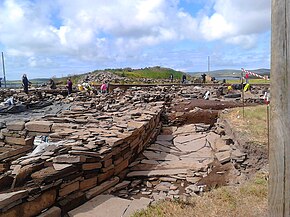Ness of Brodgar

Excavations at the Ness of Brodgar.
|
|
| Location | Mainland, Orkney |
|---|---|
| Region | Scotland |
| Coordinates | 58°59′49″N 3°12′58″W / 58.997°N 3.216°W |
| Type | Neolithic settlement or religious site |
| History | |
| Periods | Neolithic |
| Site notes | |
| Ownership | Ness of Brodgar Trust; also private ownership |
| Public access | Only by guided tour during excavation |
| Type | Cultural |
| Criteria | i, ii, iii, iv |
| Designated | 1999 (23rd session) |
| Part of | Heart of Neolithic Orkney |
| Reference no. | 514 |
| State Party | Scotland |
| Region | Europe and North America |
The Ness of Brodgar is an archaeological site covering 2.5 hectares (6.2 acres) between the Ring of Brodgar and the Stones of Stenness in the Heart of Neolithic Orkney World Heritage Site in Orkney, Scotland. Excavations at the site began in 2003. The site has provided evidence of decorated stone slabs, a stone wall 6 metres (20 ft) thick with foundations, and a large building described as a Neolithic temple. The earliest structures were built between 3,300 and 3,200 BCE, and the site had been closed down and partly dismantled by 2,200 BCE.
Today the Brodgar peninsula is a finger of land a few hundred metres wide, situated between the saltwater Loch of Stenness to the southwest and the freshwaterLoch of Harray to the northeast.
To the southeast are the Standing Stones of Stenness and to the north-west is the Ring of Brodgar. A short bridge connects these two sites. Also visible from the site are, to the east, the chambered cairn at Maeshowe and, to the southeast the Barnhouse Settlement. A couple of kilometres northwest of the Ring of Brodgar is the Ring of Bookan, a third henge, with associated mounds. The Neolithic village at Skara Brae lies a few kilometres away, as does the chambered cairn at Unstan. More archaeology is probably submerged beneath the lochs.
In Neolithic times, the Loch of Stenness was probably a wetland area rather than a lake. People from Skara Brae would have been able to walk to the Ness of Brodgar, watch or take part in ritual activity and walk home within a day.
The structures at the Ness of Brodgar are made of flagstone, a sedimentary rock found abundantly throughout Orkney. Flagstone is easily split into flat stones and was therefore a good material for fine building work using Neolithic tools. Some of the stone found on site is too thin for floor tiles or wall building, and is understood as the first evidence ever found of roofs.
...
Wikipedia

